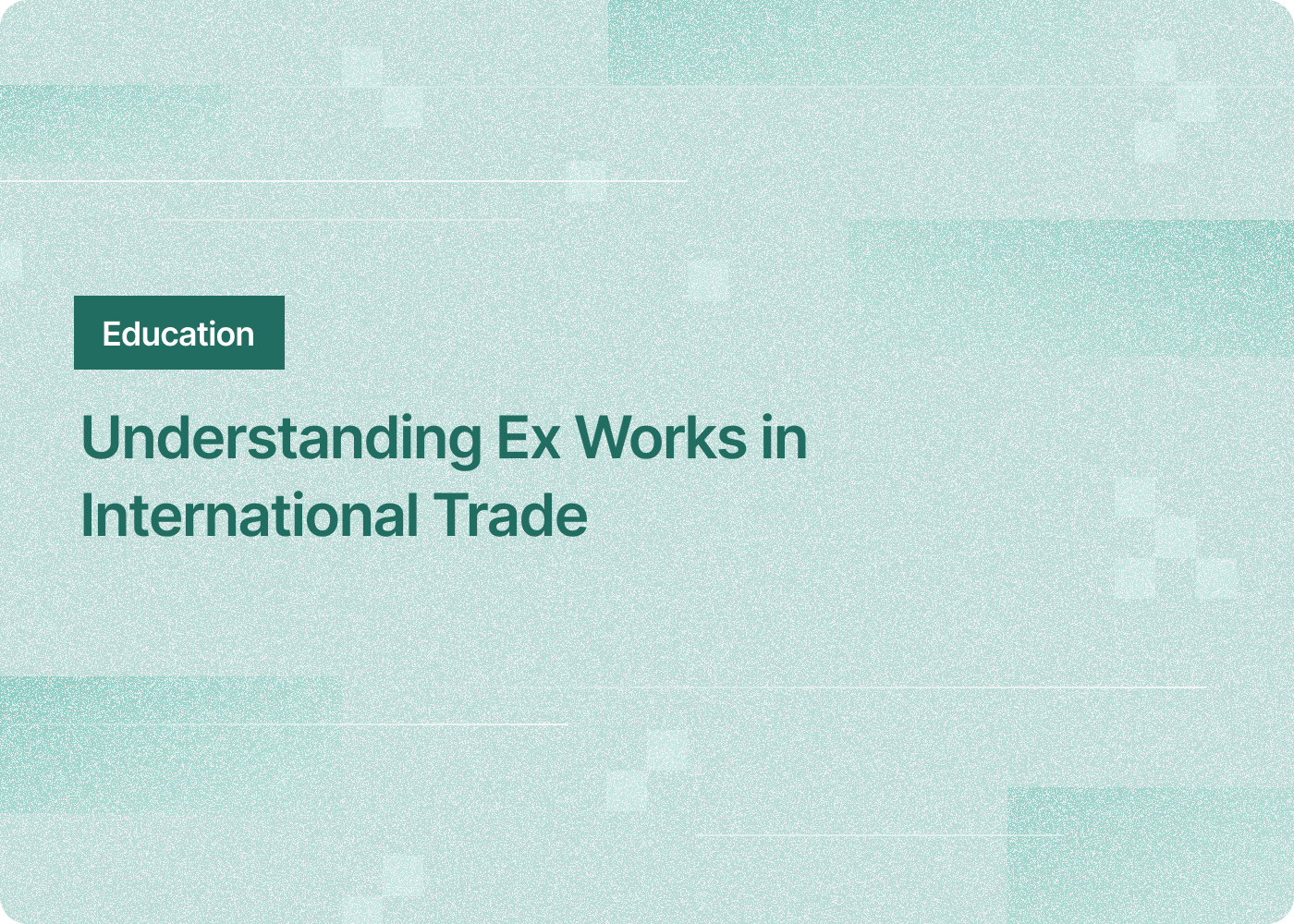Every player in the realm of international trade must, at one point or another, grapple with the intricate nuances of shipping terms. One such term that often garners intrigue is “Ex Works,” often abbreviated as EXW. At its core, it lays out a scenario where the buyer pays for nearly every expense from the seller’s premises to the final destination—transportation, shipping costs, customs clearance, and more.
Yet, why is it crucial for businesses to decipher this term? By understanding Ex Works, businesses gain clarity into their roles and responsibilities in the shipping process. It equips them with the knowledge of what happens at the seller’s factory or warehouse, what transportation costs might arise, what risks the buyer assumes, and what customs clearance processes they might need to initiate.
It’s not just about a term—it’s about understanding the balance of responsibility. By unraveling this complex tapestry, businesses can make informed decisions, negotiate better sales contracts, and navigate the sometimes murky waters of international commerce. The impact and significance of grasping ‘Ex Works’ cannot be understated—it’s the bedrock upon which many international trade deals rest.
Understanding Ex Works: The Basics and Beyond
In the sprawling world of international trade, terms and acronyms fly around boardrooms, shipping docks, and negotiation tables. Among them, ‘Ex Works’—often succinctly penned as EXW—stands tall. This shipping term, seemingly simple on the surface, carries with it intricate implications for both sellers and buyers, profoundly shaping the dynamics of a trade deal.
So, what does ‘Ex Works’ truly encapsulate? Picture this: A product rests at the seller’s premises, perhaps in a warehouse or factory. The buyer? They’re responsible for every step thereafter—from fetching the product from its origin, covering all shipping costs, navigating the maze of customs clearance, to ensuring it reaches its final destination safely. In essence, when the term ‘Ex Works’ is stamped on a deal, the onus majorly falls on the buyer’s shoulders.
But why is this term so pivotal in international commerce? Well, it’s not just about understanding who pays the freight or handles the export formalities. ‘Ex Works’ forms the foundation of many business decisions. It sets the tone for risk assessment, cost calculations, and delivery logistics. By decoding EXW, companies are better positioned to gauge their roles, responsibilities, and potential pitfalls in the shipping process.
As we delve deeper into ‘Ex Works’ in the subsequent sections, we’ll unearth its nuances, complexities, and the intrinsic relationship it shares with international trade dynamics. Whether you’re a seasoned trader or just dipping your toes into global commerce, comprehending ‘Ex Works’ is indispensable. After all, knowledge of this key term doesn’t just facilitate smoother trade—it can also be the difference between profitability and unforeseen losses.
The Critical Role of the Seller: From Premises to Ports
At first glance, ‘Ex Works’ or EXW might seem like a term that frees the seller from intricate responsibilities. The goods are ready at the seller’s premises, and from there, it’s the buyer’s game, right? Well, not entirely. While the bulk of the journey may be the buyer’s to traverse, the seller plays an irreplaceable role, standing at the pivotal intersection of product readiness and its voyage into the vast world of international trade.
Firstly, it is on the seller’s shoulders to ensure that the goods are adequately packaged, labeled, and primed for collection from their premises—be it a warehouse, factory, or any other designated location. Their responsibility does not simply end at having the product available; it extends to adhering to the standards set in the ex works agreements and meeting the buyer’s expectations.
Moreover, the dynamics of the ex works agreement introduce myriad nuances in the seller’s obligations. There are the challenges of communicating exact pick-up locations, potential domestic transport requirements within the seller’s territory, and ensuring all product-related documentation is in order. Sellers, thus, aren’t mere bystanders in this process; they lay the groundwork for a successful, smooth transaction.
As we navigate further into the realm of ‘Ex Works’, understanding these obligations and nuances is paramount. Sellers form the backbone of the initial stages of the shipping process, and their role, when executed efficiently, sets the tone for the entire transaction’s trajectory.
Buyer Pays: Responsibilities, Risks, and Rewards
The mantra “buyer pays” in the realm of international trade might seem straightforward, but as with most things, the devil is in the details. When one engages with the Ex Works (EXW) terms, it’s a dive into a world of shipping intricacies, costs, and responsibilities. For the uninitiated, it’s not just about footing the bill; it’s about navigating a labyrinth of shipping processes, customs clearances, and ensuring the goods journey smoothly from the seller’s premises to their final destination.
Shipping costs, transportation costs, import duties, and customs clearance are just the tip of the iceberg. As the name suggests, under an EXW agreement, the buyer bears nearly all the costs associated with transporting goods. From the moment the goods leave the seller’s factory or warehouse, every subsequent cost, risk, and responsibility becomes the buyer’s domain.
However, with great responsibility also comes the power of choice. The buyer has the autonomy to select the freight forwarder, determine the most efficient transport mode, and manage other shipping details as per their preferences. Yet, this autonomy is a double-edged sword; it allows flexibility but increases the buyer’s risk.
The Ex Works terms, governed by the International Chamber of Commerce, strike a delicate balance between the roles of buyers and sellers. They delineate the costs, risks, and responsibilities, ensuring that both parties are clear about their roles in the complex dance of international shipping. As we delve deeper, understanding this balance is crucial for anyone engaged in the world of trade and shipping.
The Ex Works Shipping Process: A Step-by-Step Journey
Venturing into the world of international trade can sometimes feel like decoding an enigma, and no term embodies this complexity more than “Ex Works.” When dissecting Ex Works, or EXW as it’s often abbreviated, one embarks on a meticulous journey through each stage of the shipping process, unwrapping its layers one step at a time.
Imagine a ballet: every movement, every leap, every turn, choreographed with precision. That’s the Ex Works shipping process in essence. It starts at the seller’s factory, where goods are prepared and packaged, waiting for their voyage. But unlike other shipping terms, under EXW, the narrative is chiefly led by the buyer. The seller’s role is minimal – merely to make the goods available. From this point, the responsibility shifts, and the buyer assumes command of the odyssey.
As the goods embark on their journey, they traverse various stages – customs clearance, freight forwarding, possible multiple shipments, all the way to their final destination or the buyer’s designated location. Each step is a chapter in the story of EXW, marked by tasks, risks, and costs, primarily borne by the buyer.
This roadmap of Ex Works might seem intricate, but it’s a fascinating dance of responsibilities between the buyer and the seller. As we progress, we’ll take you through each pirouette and plié of the process, ensuring you’re well-versed with the rhythm of Ex Works. Whether you’re a seasoned trader or a newbie, there’s always something new to learn in the dynamic realm of shipping and trade.
Risk, Responsibility, and Rewards: Navigating the Ex Works Landscape
At the heart of every ex works contract lies a delicate balancing act. A dance of obligations, expectations, and, most crucially, risks. While international trade offers immense opportunities, it also brings forth a multitude of complexities. Among these, understanding the nuances of the Ex Works framework is paramount.
Imagine a seesaw on a playground. On one end, we have the buyer’s risk, and on the other, the seller’s risk. The balance constantly shifts based on the stage of the shipping process and the specifics of the ex works agreement. When diving deep into this landscape, a central question emerges: Who bears what?
In the realm of Ex Works, the crux of the responsibility predominantly rests on the buyer’s shoulders. From transporting goods out of the seller’s premises to ensuring customs clearance, the onus of costs and risks lies with the buyer. On the other hand, the seller, often confined to their warehouse or factory, merely ensures the goods are available.
Yet, the allure of ex works agreements is undeniable. They offer a world where both parties, well-versed in their roles, can reap substantial rewards. But unlocking these benefits requires a clear understanding of the costs, risks, and potential rewards. As we journey further, we’ll unravel the intricacies of the Ex Works tapestry, offering clarity in a domain often marked by uncertainty.
Comparing Ex Works with Other Shipping Terms
In the vast realm of international trade, few terms carry as much weight and significance as the shipping terms. These terms, like ancient codes, guide the rituals of trade, dictating the dance of sellers and buyers across borders. Among the most prominent of these terms are Ex Works (EXW) and Free Carrier (FCA).
Both Ex Works (EXW) and Free Carrier are quintessential to the shipping process, each offering its unique blueprint for the movement of goods. At a glance, Ex Works might seem like a simple concept: the seller delivers the goods at their warehouse or seller’s factory, and from that point, the buyer assumes the lion’s share of responsibility. But there’s more than meets the eye.
Contrastingly, in a Free Carrier agreement, the seller clears the goods for export, and then delivers them to a designated location, often involving a freight forwarder chosen by the buyer. Here, the balance of costs and responsibilities is subtly different.
The myriad complexities of these terms can sometimes feel labyrinthine. Should a buyer opt for Ex Works and take on more of the shipping costs and customs clearance responsibilities? Or should they lean towards Free Carrier, with its nuanced distribution of shipping responsibilities?
The choice between Ex Works and Free Carrier isn’t just about costs; it’s a strategic decision, interwoven with factors like the seller’s location, export formalities, and desired control over the shipping process. This guide seeks to illuminate these pathways, enabling traders to navigate the intricate world of shipping terms with confidence and clarity.
The Hidden Costs of Ex Works: A Financial Breakdown
The allure of Ex Works (EXW) often lies in its apparent simplicity. At first glance, it may seem straightforward: the seller prepares the goods, ready for pickup at their premises, be it a warehouse or factory. However, beneath this facade, there lies a network of intricate financial responsibilities that can sometimes surprise the uninitiated.
Both the buyer and seller must grapple with a variety of costs, from loading charges at the seller’s factory to the nuanced world of transportation costs. But the financial journey doesn’t stop there. The intricate ballet of customs clearance, the securing of export licenses, and the myriad of other formalities, each come with their price tags, further shaping the overall cost structure.
For the astute player in the international trade arena, understanding these costs isn’t just about avoiding surprises. It’s about strategizing, budgeting, and making informed decisions in the ever-evolving world of shipping terms. This breakdown seeks to shed light on these often-overlooked expenses, guiding traders towards more transparent and profitable arrangements.
Conclusion: Reflecting on the Importance of Ex Works in Global Commerce
In the vast landscape of international trade, the term Ex Works (EXW) stands out not just as a mere shipping term, but as a cornerstone of global commerce. Its influence resonates through each transaction, each negotiation, and each shipment. Yet, its true depth often remains uncharted territory for many businesses.
The intricate interplay between buyers and sellers, the dance of responsibilities, risks, and costs—all are embedded within the EXW framework. As the dynamics of global commerce evolve, understanding and navigating Ex Works effectively isn’t just an advantage; it’s a necessity.
To the businesses poised at the frontier of international markets: Take heed. Delve deeper into Ex Works, embrace its complexities, and arm yourself with the knowledge that could be the linchpin of your next successful venture. As we’ve journeyed through the facets of EXW, one message remains clear: to thrive in global trade, mastering Ex Works is not just an option—it’s an imperative.



